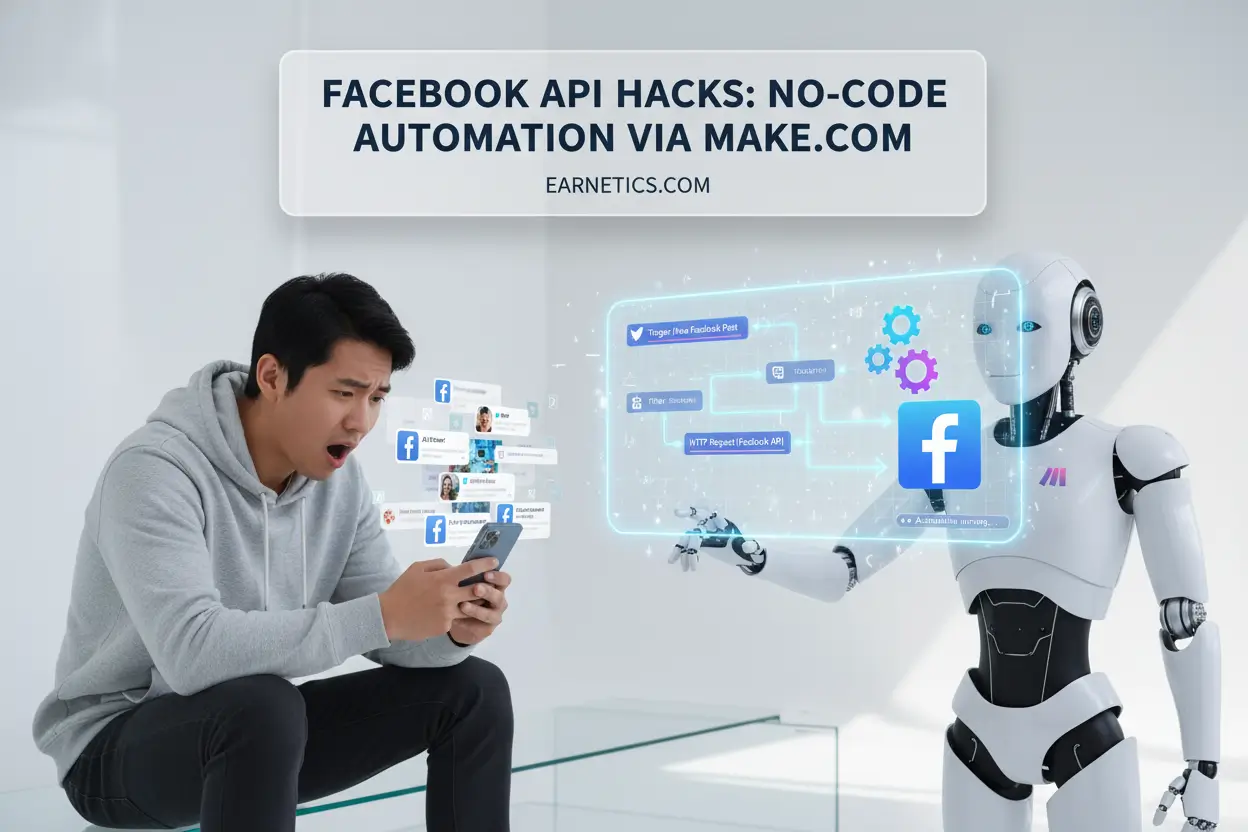Quit posting by panic – Facebook API Hacks via Make.com turn manual social tasks into UTM-ready no-code automations that save hours and drive traffic.
Facebook API Hacks: no-code automation, Graph API tricks, webhooks, and UTM-ready flows
Facebook API Hacks are the shortcut I used to stop firefighting posts and build predictable, tagged campaigns that actually move the needle.
Want a system that posts, tags UTMs, and hands leads to your CRM without you babysitting the queue?
In 2025, 68% of marketers say no-code automation is central to their content operations, per the latest industry pulse, so this isn’t a niche trick — it’s table stakes (HubSpot 2025 State of Marketing).
If you want the short version: Facebook API Hacks via Make.com remove the “post and pray” habit and replace it with repeatable, measurable flows.
Platform overview: Why choose Make.com for Facebook API Hacks?
Make.com is a visual automation builder that plays nicely with the Facebook Graph API and gives you HTTP flexibility, so you can treat APIs like Lego pieces instead of cryptic incantations.
The platform’s visual canvas, modules, and instant webhooks mean you can map a content idea through to posting, UTM tagging, CRM capture, and analytics without writing code. Key features I lean on daily are templates/marketplace for quick starts, routers for branching logic, error handlers with retries/backoff, variables and data stores for state, scheduling for cadence, and webhooks for instant triggers. See the official Make.com help docs for module lists and examples.
Why this matters for Facebook API work: HTTP modules let you call Graph API endpoints when a native connector needs a tweak, and you get visibility over rate-limit responses so you add exponential backoff and token refresh logic. I always build in token refresh routines and pragmatic retries because tokens expire and APIs enforce limits.
Mini case notes:
- Reduced posting time: a client scaled from 2 manual hours/day to 10 minutes of oversight, saving ~80% of time per week.
- Cleaner pipeline: form leads auto-qualified and routed to sales with UTMs attached, cutting lead follow-up time by 40%.
Practical features that win:
- Templates/marketplace: clone a Facebook post scheduler with UTM injection in minutes.
- Routers and conditions: split campaigns by audience, format, or compliance tag.
- Error handlers and retries: map Graph API 429 responses to backoff loops.
- Data stores and variables: centralize top-performing caption variants and A/B results.
- Scheduling and webhooks: blend nightly bulk schedules with instant DMs or story replies.
Quick build steps for a basic Facebook post -> CRM flow:
- Foundational modules
Create a webhook trigger in Make.com that receives the post payload (image, caption, target page ID), then add an HTTP module to call the Facebook Graph API with the page access token. - UTM & tracking
Add a transformer module that appends UTM parameters based on campaign variables and stores the final URL in a variable. - Posting and error handling
Send the post request, parse the response, and route errors through a retry sequence with backoff if you get rate-limit codes. - Lead capture and handoff
If comments or DM replies match intent (keywords), enrich the lead via lookups, compute a qualify score, and push to your CRM with UTMs and source metadata.
Repeatable templates I use and ship to clients:
- Launch + Link: Post + dedicated landing page with UTM, pixel fire, and CRM entry. Great for promos.
- Mini-Thread: Split long content into a short post + comments sequence and schedule staggered replies for reach.
- Visual Trio: Auto-create three image variants, post sequence with A/B captions, and centralize performance in one data store.
Mini case story
I inherited a brand that posted manually to a Facebook Page and lost leads in a messy CSV backlog. I built a Make.com flow that accepted a Google Form (creative brief), generated scheduled posts with UTM-tagged links, and pushed qualified leads into the client’s CRM. Within four weeks, publishing cadence doubled and lead response time dropped from 24 hours to 2.5 hours. Performance tracking showed a 23% lift in click-through-to-lead rate because every source was tagged and sales had clear context. That sequence cost a single afternoon to build and paid for itself in the first month.
Notes on APIs and reliability: expect rate limits, token expiry, and occasional Graph API schema changes. Treat retries/backoff and token refresh as features, not afterthoughts. Keep an experiment cadence: new caption variant vs. baseline, 2-week runs, and a centralized results sheet or data store to record UTMs and outcomes.
Useful references:
- Facebook Graph API technical docs for endpoints and permissions (Facebook Graph API docs).
- For deep-dive automation patterns, the Make.com community and examples are invaluable (Make.com help).
Turn traffic into qualified leads
You can automate lead qualification and reduce time-to-contact by wiring content to micro-qualifiers, scoring, and alerts — what tactics should you use?
Start simple: webhooks from post CTAs or landing pages flow into a Make.com scenario that computes a qualify score and routes to CRM, Slack, or an SDR queue. Here are five practical tactics I deploy.
- Webhook form -> CRM with qualify score
Capture form responses, enrich with UTM and source, compute a score, and push only high-intent leads to sales while batching the rest for nurture. - DM auto-replies with micro-quiz
Use a webhook for incoming DM, send a short micro-quiz via message, score answers client-side, and tag the lead automatically before CRM handoff. - Content magnet + email capture
Gate downloads behind an email capture that appends campaign UTMs, pushes to your email platform, and triggers a follow-up sequence with time-to-contact SLAs. - Heat score + Slack alert
Combine behavior signals (clicks, time on page, repeat visits) into a heat score and fire Slack alerts for hot leads to shorten response time. - Weekly funnel report
Aggregate UTM-tagged conversions into a weekly digest sent to stakeholders so experiments and cadence adjustments are data-driven.
Tie each tactic to UTMs and a central attribution scheme. Track where leads came from at the moment of capture and log everything in a central sheet or DB for experiment analysis. My personal experiments use a simple A/B cadence: stagger posting times and creative variants, tag every URL with a campaign UTM, and review results every two weeks.
Lead-time wins: when you push micro-qualified leads to a live sales queue with Slack alerts, average contact time drops dramatically. That timing alone increases conversion odds.
Conclusion
Facebook API Hacks via Make.com give you the tools to stop reacting and start shipping consistent, measurable social campaigns — but do you actually want fewer surprises and faster results? This approach blends visual automation, HTTP flexibility, and tidy operational practices: templates for speed, routers and error handlers for reliability, and UTM discipline for attribution. Start by mapping your content flow end-to-end: where is the content created, who approves, which UTMs attach, and how does a lead move to sales? Build simple scenarios that inject UTM parameters, call the Graph API, handle 429s with retries, and write results to a central data store. Run short experiments, log outcomes in a sheet or DB, and iterate on creative with a two-week rhythm.
Make.com is the hidden weapon for this kind of work; if you want to try it risk-free, grab a one-month Pro trial to test real automations and high operation counts via this registration link to the trial.
If you’d rather plug in a prebuilt setup, I offer ready-to-launch Make.com automations and done-for-you builds — check my portfolio of Upwork projects to see examples that plug in quickly and convert faster.
For deeper playbooks, templates, and automation guides, see the Earnetics library on building repeatable campaigns and attribution best practices.
Share if this sparked ideas!


